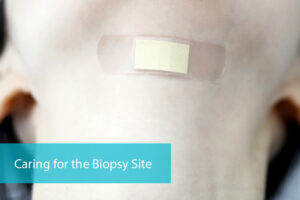
Undergoing a biopsy can be a nerve-wracking experience, laden with anxiety about both the procedure and the results. However, what often doesn’t receive as much attention but is equally crucial is the post-biopsy care. Proper care after a biopsy is essential for a smooth recovery and can significantly reduce the risk of complications. This extensive guide is designed to provide you with thorough tips and advice, spanning from immediate care to long-term monitoring, to ensure your post-biopsy journey is as comfortable and informed as possible.
Understanding Biopsy Recovery
Immediate Post-Biopsy Care: After the procedure, the medical staff will typically apply a sterile dressing or bandage to the site. It is crucial to keep this dressing clean and dry to prevent infection. Depending on the biopsy type, you might also have stitches that will need care or eventual removal.
Rest and Activity Levels: Your doctor will likely advise you to rest for at least the first 24 hours post-biopsy. This rest period is vital for your body to start the healing process. Avoid any strenuous activities or heavy lifting for a few days or as advised.
Managing Pain and Discomfort
Over-the-Counter Medications: Mild pain or discomfort at the biopsy site is normal. Over-the-counter pain relief like acetaminophen can be used, but it is crucial to avoid aspirin or other blood thinners unless your doctor says otherwise, as they can increase bleeding risk.
Cold Compresses: For biopsies involving larger tissue areas, such as a breast biopsy, using a cold pack can help minimize swelling and bruising. Always wrap ice packs in a cloth to avoid direct contact with the skin and limit use to 20-minute intervals.

Caring for the Biopsy Site
Cleanliness and Dressing Changes: Keep the area clean and dry. If you have a dressing, you’ll need to change it as directed by your healthcare provider. If the site was closed with stitches, follow your doctor’s advice on how to care for them, and be sure to attend any appointments for their removal.
Signs of Infection: Be vigilant for any signs of infection, which can include increased redness, warmth, swelling, pus, or a foul odor emanating from the biopsy site. Fever and increased pain are also red flags. If you notice any of these symptoms, contact your healthcare provider immediately.
Caring for the biopsy site is crucial for preventing infection and ensuring a smooth healing process. Here’s a detailed guide to help you manage and monitor the area effectively:
Immediate Aftercare
Post-Procedure Instructions: Carefully listen to and follow the instructions provided by your healthcare professional. These instructions are tailored to the type of biopsy you’ve had and your individual health needs.
Rest: Keep the biopsy area as still as possible for the first few hours post-procedure to reduce bleeding and aid in clot formation.
Dressing and Bandages
Initial Dressing: The initial dressing applied by your healthcare provider is usually meant to stay on for at least the first 24 hours unless it becomes wet or dirty. This helps to protect the wound and absorb any minor bleeding or oozing.
Changing the Dressing: When it’s time to change the dressing, do so in a clean environment. Wash your hands thoroughly before touching the dressing, and gently remove it. If the dressing sticks, you can moisten it with a little sterile water or saline to ease it off.
Applying New Dressing: After cleaning the area as advised, dry it gently and apply a fresh, sterile bandage. Ensure the dressing is secure but not too tight to cut off circulation.
Cleaning the Biopsy Site
Frequency and Products: Clean the biopsy site as often as recommended, usually once or twice daily. Use mild soap and water or a saline solution, unless told otherwise. Avoid alcohol or hydrogen peroxide unless specifically instructed, as these can delay healing.
Technique: Gently dab or pour the cleaning solution over the site. Do not rub, as this can disturb the healing tissue. Pat the area dry with a clean towel or gauze.
Monitoring for Infection
After a biopsy, your body is working hard to heal the area where tissue was removed. During this time, it is crucial to be vigilant for signs of infection, as the wound created during the procedure can be vulnerable to bacteria and other pathogens. Symptoms of infection you should be aware of and what to do if you notice them:
Increased Redness: It is normal for the biopsy site to be slightly red as part of the initial healing process. However, if the redness starts to spread or become more pronounced several days post-procedure, it may indicate an infection. The red area might also feel warm or hot compared to the surrounding skin.
Warmth: Along with redness, an increase in warmth, specifically at the site of the biopsy, is a common sign of infection. The warmth is due to increased blood flow as your body tries to fight off the invading bacteria.
Swelling: Some swelling after a biopsy is normal, but it should gradually improve. If the swelling increases, becomes more pronounced, or spreads, it may be a sign of an infection. The area may also feel tight or stretched and might be tender to touch.
Pus or Discharge: Any pus or unusual discharge from the biopsy site is a clear indicator of infection. The pus may be white, yellow, green, or even slightly bloody and can have a thick consistency. It’s a collection of dead white blood cells, bacteria, and damaged tissue and is a sign that your body is fighting an infection.
Foul Odor: An unpleasant smell emanating from the biopsy site can also indicate an infection. This odor is usually due to the presence of bacteria or necrotic (dead) tissue.
Fever: Developing a fever after a biopsy is a systemic response to infection. It indicates that your body is trying to fight off the invading pathogens. Any fever — generally considered a body temperature above 100.4°F (38°C) — following a biopsy should be taken seriously.
Increased Pain: While some pain or discomfort is expected after a biopsy, this should gradually improve. If the pain worsens, becomes sharp or throbbing, or starts spreading, it could be due to an infection.
Managing Pain and Swelling
Cold Compress: In the first 24-48 hours, applying a cold compress can help reduce swelling and numb the area, decreasing pain. Always wrap the ice pack in a cloth to protect your skin and limit application to 15-20 minutes at a time to prevent frostbite.
Elevation: If possible, keep the biopsy area elevated above the level of your heart. This can reduce swelling and discomfort, especially for biopsies of the extremities.
Avoiding Irritation
Clothing: Wear loose, soft clothing that doesn’t rub against the biopsy site. Avoid tight or abrasive fabrics that might irritate the area.
Activity: Avoid activities that might stretch, rub, or put pressure on the biopsy site for as long as your doctor recommends. This includes both physical activities and things like scrubbing the area when bathing.
Knowing When to Seek Help
Unexpected Symptoms: If you experience severe bleeding, intense pain, or other unexpected symptoms, seek medical attention immediately. It is better to be cautious and get checked out than to wait and potentially allow a complication to worsen.
By carefully following these detailed care instructions, you can help ensure a smooth and straightforward recovery from your biopsy. Remember, the way you care for your biopsy site plays a crucial role in your overall healing process. If ever in doubt, do not hesitate to contact your healthcare provider for guidance and support.
Nutrition and Hydration for Healing
Hydration: Adequate fluid intake is essential after a biopsy. Water aids in the transportation of nutrients to the wound site and in the removal of waste products from the body, both of which are crucial for healing.
Balanced Diet: A diet rich in proteins, vitamins (especially vitamins C and A), and minerals (like zinc) can expedite your recovery. These nutrients are the building blocks your body needs to repair tissue and regenerate cells.

Emotional and Mental Health Care
Anxiety Management: Waiting for biopsy results can be emotionally taxing. Techniques such as deep breathing, meditation, or gentle yoga can help manage anxiety. Ensure you have a good support system in place; talking things over with loved ones can provide significant relief.
Professional Support: If your anxiety or stress feels unmanageable, consider seeking support from a counselor or therapist who can provide strategies to cope with the waiting period and the uncertainty.
Follow-Up and Understanding Results
Scheduling Follow-Up Appointments: Make sure you understand when and how you will receive your biopsy results. Have a follow-up appointment scheduled to discuss the findings and next steps. Use this time to ask any questions about the results, implications, and future care.
Preparing for the Results: It is normal to feel apprehensive about biopsy results. Prepare a list of questions for your healthcare provider, and consider bringing a family member or friend for support. Understand that results can sometimes be inconclusive, requiring further testing or follow-up procedures.

Long-Term Care and Monitoring
Ongoing Health Monitoring: Depending on the biopsy results, your doctor may recommend regular monitoring. This might include additional tests, routine check-ups, or lifestyle modifications to manage or treat any discovered condition.
Awareness and Advocacy:
- Stay attuned to your body.
- If you notice any new symptoms or changes, inform your healthcare provider promptly.
- Be an advocate for your health by staying informed, asking questions, and maintaining a proactive approach to your well-being.
Conclusion
Recovering from a biopsy is a process that encompasses not just physical care but also emotional and mental support. Each step, from understanding how to care for your wound to managing anxiety while awaiting results, is crucial in ensuring a smooth and comfortable recovery. Remember, you are not alone in this journey. Healthcare providers, support groups, friends, and family are valuable resources that can provide guidance and support. By taking an active role in your post-biopsy care and staying informed, you can navigate this path with greater ease and confidence. Your health and peace of mind are paramount, so take the time to care for both as you recover from your biopsy.





